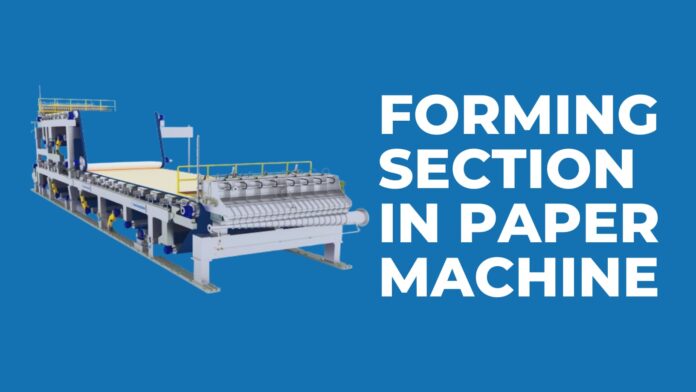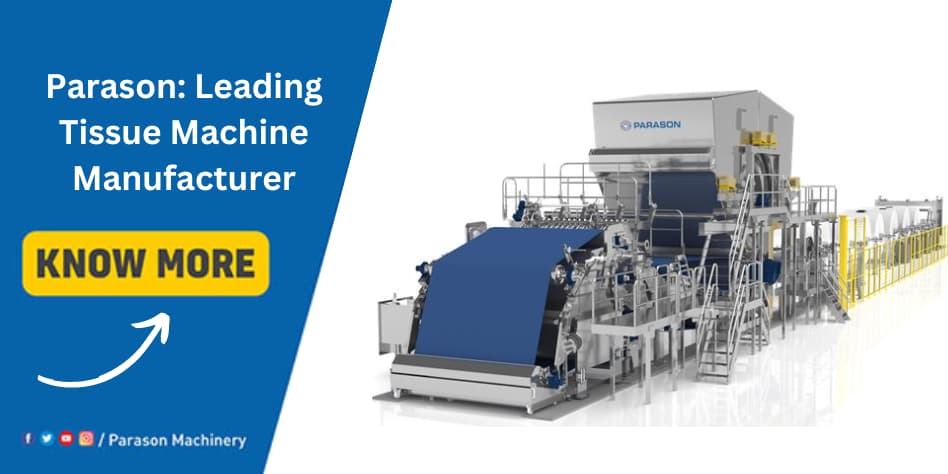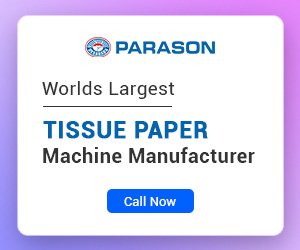The paper industry serves many needs of our daily lives, including education, packaging, hygiene, and countless others. To produce all kinds of paper, the forming section in the paper machine plays a crucial role. The forming section is where the paper sheet from the pulp starts to form.
In this blog, we will discuss the forming section in a paper machine, the equipment used in the forming section, its application, and working principles while also focusing on the customization options for the forming section.
What is the Forming Section in a Paper Machine?
The forming section is a part of the paper manufacturing process. It is the section in the paper machinery where the pulp slurry consisting of water and fibers, is introduced and transformed into a continuous paper sheet.
The forming section in the paper machine serves the primary function as to ensure that the paper fibers are uniformly distributed and precisely formed into a thin sheet as per the requirement. This sheet can then proceed to the pressing and drying section for further processing to form a paper.
The forming section is a critical part of the paper machine as the quality and consistency of the paper largely depend on how well the pulp is formed. The uneven fiber distribution, excessive water retention, or poor bonding can negatively impact the final product’s strength, appearance, and printability.
Paper Machines Involved in the Forming Section
The forming section in the paper machine consists of several key components. These components are designed to facilitate pulp’s transition from a liquid to a semi-solid state. Let’s see the most important machinery and equipment used in the forming section.
- Headbox: The Headbox is where the pulp slurry is introduced onto the wire section. The headbox ensures that the pulp is spread evenly across the width of the machine. The turbulence generators in modern headboxes maintain uniformity and prevent fiber flocculation. There are different types of headbox with unique working principles.
- Wire: This continuous loop of wire mesh carries the pulp slurry as water is drained through it. The wire section is important in proper formation of the paper sheet and the dewatering.
- Foils and Table Rolls: These devices assist in the drainage of water from the slurry while the fibers are being deposited onto the forming fabric. Foils provide a controlled vacuum to help remove excess water, while table rolls provide additional support to the fabric.
- Vacuum Boxes: These are positioned beneath the Wire to help remove water through suction, further aiding the dewatering process.
- Forming Board: Located at the start of the forming section, it helps the pulp to hit the fabric at the correct angle and speed to ensure proper formation.
- Hydrofoils: The hydrofoils are placed under the wire and help with water drainage while promoting fiber orientation to improve the paper’s strength.
Working Principle and Application of the Forming Section in Paper Machine
The primary and important application of the forming section in a paper machine is to form a continuous and uniform sheet of paper from the pulp slurry. This further includes the dewatering of the paper web to get the required dryness of the paper.
The working principle of the forming section revolves around the precise control of the dewatering process. Let’s see how the forming section is operated step-by-step.
- Pulp Delivery: The pulp, consisting of water and fiber, is delivered from the headbox onto the wire.
- Initial Formation: As the slurry spreads across the fabric, gravity, and the forming board ensure an even distribution of fibers. Water begins to drain through the wire by gravity and the use of foils.
- Dewatering: As the forming fabric moves forward, vacuum boxes pull more water through the wire. This step significantly reduces the water content and helps form the paper sheet.
- Fiber Orientation: While the water is drained, the motion of the fabric and foils helps place the fibers in a specific direction, influencing the paper’s strength and properties.
- Roll: At the end of the forming section, the couch roll squeezes out the remaining water and delivers the wet web to the pressing section for further drying.
Customization in the Forming Section
The forming section can be customized based on the type of paper being produced, the machine speed, and the desired product characteristics. Here are some of the customizations which can be done in the forming section as per the requirement.
- Multiple-layer headboxes: For producing multi-layered paper such as cardboard or high-quality printing paper.
- Hybrid Formers: Combining different forming technologies to meet specific paper qualities.
- Twin-Wire: For high-speed machines, twin-wire systems offer more efficient water removal and improve the uniformity of the paper web.
There can be more customization as per your paper production requirements. If you have a specific need for forming a section in a paper machine or any of the paper manufacturing equipment, you can contact us, and we will guide you to the best output.
Conclusion
The forming section in the paper machine is an important section where the quality and the strength of the final product can be achieved. With different applications, different requirements, and different types of paper, the forming section can be customized to match your final product’s requirements.


